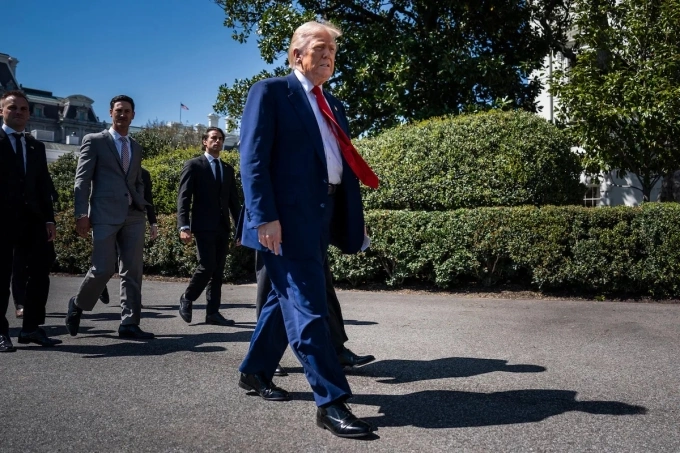
18 Hours of Turmoil Prompt Trump to Hit Pause on Tariffs
Less than two days after declaring that his new tariffs were "working beautifully," President Donald Trump abruptly announced a 90-day delay on most retaliatory tariffs on April 9—following a whirlwind 18 hours of political pressure, market turmoil, and behind-the-scenes lobbying from top allies and business leaders.
The decision marked a dramatic shift from Trump’s earlier stance. After unveiling sweeping tariffs on 180 trade partners on April 2, the president had doubled down on the policy despite backlash from Republican lawmakers, business leaders, and even close advisers like Elon Musk. The stock market reacted sharply, adding to growing concerns inside the West Wing.
“They’re angry. There’s a little fear too,” Trump acknowledged of the pushback during the week. Still, he maintained publicly that his policy was not changing. “My policy will not shift,” he wrote on Truth Social over the weekend.
On April 8, speaking in the White House East Room before lawmakers and industry leaders, Trump boasted that the tariffs were generating $2 billion per day for the U.S. economy, calling them a "breakthrough" in his economic strategy. But later that evening, after watching Fox News host Sean Hannity’s segment featuring concerned GOP senators, Trump called several of them for over an hour. The message: the new tariffs were triggering alarm bells.
Simultaneously, Trump was closely watching Treasury bond markets, which saw a steep sell-off that night—signaling deeper economic concerns than his advisers had anticipated.
By the early hours of April 9, the U.S. was imposing its highest tariffs on foreign goods in over a century, with China facing the steepest hike—an 84% retaliatory rate—raising its total tariff burden to 104% under Trump’s second term. That morning, Trump met with Senate Majority Leader John Thune and spoke with Swiss President Karin Keller-Sutter, whose country faced a 31% tariff on watches and chocolate.
In a 25-minute call, Keller-Sutter reminded Trump that Switzerland had removed industrial tariffs on U.S. imports in 2023 and emphasized the country’s role in supporting U.S. jobs.
Later, Trump tuned into an interview with JPMorgan Chase CEO Jamie Dimon, who warned that ongoing economic instability could trigger a recession. “Things could get worse if we don’t see progress,” Dimon cautioned.
Shortly after, Trump took to Truth Social: “Everything will be fine. America will be stronger and better than ever.” Minutes later, he posted, “Great time to buy!”
Meanwhile, Commerce Secretary Howard Lutnick fielded a call from EU trade chief Maros Sefcovic, who warned that the bloc would slap a 25% tariff on a wide range of U.S. goods starting April 15.
Inside the White House, Republican allies and CEOs bombarded Trump’s senior staff with calls urging a tariff rethink. Aides including Chief of Staff Susie Wiles and Treasury Secretary Scott Bessent were reportedly pivotal in persuading the president to reconsider, warning that a continued market downturn could undermine political support.
According to sources, Wiles convinced Trump that market collapse could derail his broader agenda. Trump later acknowledged on Truth Social: “I’ve been watching the bond market—it’s complex. Things are good, but yes, there was concern last night.”
By midday on April 9—just 18 hours after insisting his policy was firm—Trump summoned Lutnick and Bessent to the Oval Office, where he agreed to temporarily scale back tariffs. The move caught even some of his closest allies off guard. Notably absent from the meeting: longtime trade advisor Peter Navarro, seen as the architect of Trump’s hardline tariff policy.
Later that day, Trump announced the 90-day pause on most tariff increases while maintaining the base 10% rate for most countries. However, tariffs on Chinese goods were raised immediately to 125%, citing Beijing’s “disrespect for global markets.”
Speaking from the South Lawn, Trump said the issue was not over. “But we’re seeing goodwill from other nations,” he said. “We’ll achieve something no one thought possible.”
Following the announcement, White House officials quickly framed the reversal as part of a master plan. “Brilliant strategy. Bold policy. The president’s vision is reshaping global trade,” Deputy Chief of Staff Stephen Miller posted on X.
Treasury Secretary Bessent insisted the decision was not a reaction to market volatility but part of a long-laid strategy. “This was always the president’s plan,” Bessent said. “We discussed this extensively on April 6.”
Still, Trump later admitted he closely monitors the markets. “What happened in the markets the past few days is unfortunate,” he told reporters. “But you have to be flexible. Markets change—and so do you.”
(Sources: The Washington Post, CNN)
Hello Shuttle will strive to bring the latest updates. At the end of the day.
Are you looking for reliable airport and cruise port transfer services in Los Angeles?
We offer professional, safe, and punctual transportation from
Los Angeles Airport - LAX
Long Beach Airport - LGB
John Wayne Airport - SNA
San Pedro cruise port
Long Beach cruise port
Disneyland
and other destinations.
Let us make your journey stress-free and comfortable with our dedicated drivers and high-quality vehicles. Book now for the perfect travel experience at www.helloshuttle.com or call 944-800-5678!


